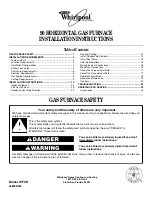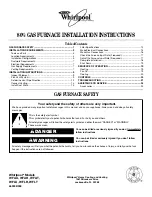
F96CTN and G96CTN (Series A): Installation, Start-up, Operating, Service and Maintenance Instructions
Manufacturer reserves the right to change, at any time, specifications and designs without notice and without obligations.
73
shut OFF and remain OFF for the blower-ON delay (45 sec in
low-heat, and 25 sec in high-heat), allowing the furnace heat
exchangers to heat up more quickly, then restarts at the end of the
blower-ON delay period at low-heat or high-heat airflow,
respectively.
The blower motor BLWM will revert to continuous-blower airflow
after the heating cycle is completed. In high-heat, the furnace
control CPU will drop the blower motor BLWM to low-heat airflow
during the selected blower-OFF delay period before transitioning to
continuous-blower airflow.
When the thermostat “calls for low-cooling”, the blower motor
BLWM will switch to operate at low-cooling airflow. When the
thermostat is satisfied, the blower motor BLWM will operate an
additional 90 sec at low-cooling airflow before transitioning back to
continuous-blower airflow.
When the thermostat “calls for high-cooling”, the blower motor
BLWM will operate at high cooling airflow. When the thermostat is
satisfied, the blower motor BLWM will operate an additional 90 sec
at high-cooling airflow before transitioning back to
continuous-blower airflow. When the R-to-G circuit is opened, the
blower motor BLWM will continue operating for an additional 5
sec, if no other function requires blower motor BLWM operation.
Continuous Blower Speed Selection from Thermostat
To select
different continuous-blower airflow from the room thermostat,
momentarily turn off the FAN switch or push button on the room
thermostat for 1-3 sec after the blower motor BLWM is operating. The
furnace control CPU will shift the continuous-blower airflow from the
factory setting to the next highest CF selection airflow as shown in
. Momentarily turning off the FAN switch again at the thermostat
will shift the continuous-blower airflow up one more increment. If you
repeat this procedure enough you will eventually shift the
continuous-blower airflow to the lowest CF selection as shown in
. The selection can be changed as many times as desired and is
stored in the memory to be automatically used following a power
interruption.
NOTE:
If the blower-off delay is set to the maximum, the adjustable
continuous-fan feature is locked (i.e., fan speed cannot be changed from
its current setting).
7.
Heat pump
See
for thermostat connections.
When installed with a heat pump, the furnace control automatically
changes the timing sequence to avoid long blower off times during
demand defrost cycles. Whenever W/W1 is energized along with
Y1 or Y/Y2, the furnace control CPU will transition to or bring on
the blower motor BLWM at cooling airflow, low-heat airflow, or
the mid-range airflow, whichever is lowest. The blower motor
BLWM will remain on until the main burners ignite then shut OFF
and remain OFF for 25 sec before coming back on at heating
airflow. When the W/W1 input signal disappears, the furnace
control begins a normal inducer post-purge period while changing
the blower airflow. If Y/Y2 input is still energized the furnace
control CPU will transition the blower motor BLWM airflow to
cooling airflow. If Y/Y2 input signal disappears and the Y1 input is
still energized the furnace control CPU will transition the blower
motor BLWM to low-cooling airflow. If both the Y1 and Y/Y2
signals disappear at the same time, the blower motor BLWM will
remain on at low-heat airflow for the selected blower-OFF delay
period. At the end of the blower- OFF delay, the blower motor
BLWM will shut OFF unless G is still energized, in which case the
blower motor BLWM will operate at continuous blower airflow.
Component Self-Test
Refer to “Component Self Test” in the Service and Maintenance section
for details.




































